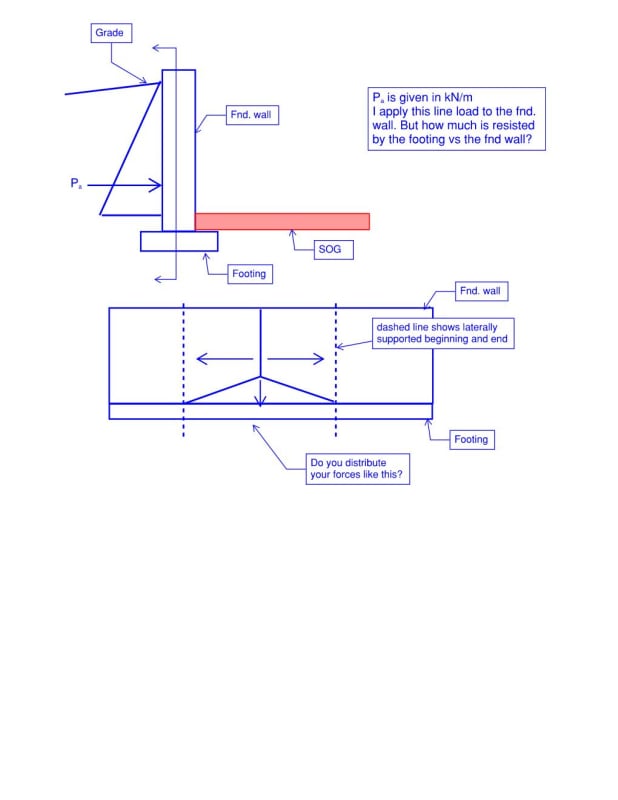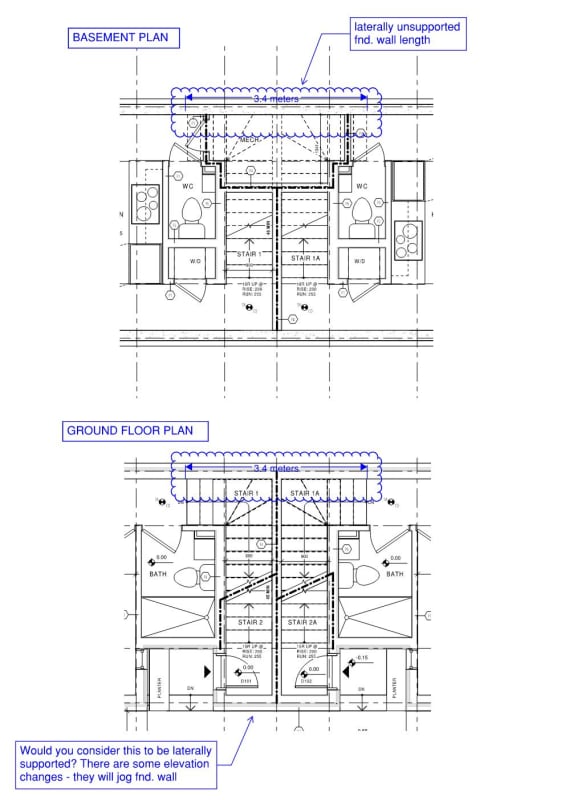Navigation
Install the app
How to install the app on iOS
Follow along with the video below to see how to install our site as a web app on your home screen.
Note: This feature may not be available in some browsers.
More options
Style variation
-
Congratulations cowski on being selected by the Eng-Tips community for having the most helpful posts in the forums last week. Way to Go!
You are using an out of date browser. It may not display this or other websites correctly.
You should upgrade or use an alternative browser.
You should upgrade or use an alternative browser.
Is this a laterally unsupported fnd. wall?
- Thread starter TORCHMAN
- Start date
- Status
- Not open for further replies.
- Thread starter
- #3
Thanks KootK. Yes, the landings are wood.
When I design the laterally unsupported fnd. wall, I typically consider the connection at each side of the fnd. wall to be fixed. I typically spec one layer of reinforcement that works for both moments if possible.
Do you typically spec 2 matts of bar?
When I design the laterally unsupported fnd. wall, I typically consider the connection at each side of the fnd. wall to be fixed. I typically spec one layer of reinforcement that works for both moments if possible.
Do you typically spec 2 matts of bar?
milkshakelake
Structural
I generally specify rebar on each face. But that's more because I don't want to run a calculation and use different rebar in one area of the foundation wall; might get screwed up on job site. It's also generally accepted where I practice. In some places, one layer of rebar might be the norm.
If you're specifying one layer of rebar for negative and positive moment, it'll have to be in the center of the wall, which isn't very efficient. Low d for both directions. That being said, if it works, it works.
If you're specifying one layer of rebar for negative and positive moment, it'll have to be in the center of the wall, which isn't very efficient. Low d for both directions. That being said, if it works, it works.
I probably wouldn't consider it fixed if it was up to me, but that would be situationally dependent. On a single family residence with an 8" wall, I would design the wall as pinned where it gets diaphragm support again and only put bars on the inside face.
On a multi tenant or commercial building with 10" concrete walls, fixed all day with 2 mats of bar, but those walls have 2 mats all the time anyway.
On a multi tenant or commercial building with 10" concrete walls, fixed all day with 2 mats of bar, but those walls have 2 mats all the time anyway.
- Thread starter
- #6
milkshakelake said:If you're specifying one layer of rebar for negative and positive moment, it'll have to be in the center of the wall, which isn't very efficient. Low d for both directions. That being said, if it works, it works.
That's what I am going with. The d is low but does the trick. I figure it is better to put one matt of 15M than 2 mats of 10M from both a labour and material perspective.
jayrod12 said:I probably wouldn't consider it fixed if it was up to me, but that would be situationally dependent. On a single family residence with an 8" wall, I would design the wall as pinned where it gets diaphragm support again and only put bars on the inside face.
On a multi tenant or commercial building with 10" concrete walls, fixed all day with 2 mats of bar, but those walls have 2 mats all the time anyway.
Interesting. I analyzed as fixed on both sides, which creates a negative moment that is higher than the positive moment, but 2/3 lower than the positive moment if it were simply supported. (wl^2)/8 vs (wl^2)/12. I used to think of it the same, where I put the bar on the inside face, but then if I consider it fixed, I get a negative moment that would be completely unaddressed if the bar is on the inside. These are very different results when it comes to analysis.
Another question. Do you assume that part of the lateral force is resisted by the footing rather than the fnd wall? I find the design quite conservative if I assume the fnd. wall to take the whole load. Below is a sketch. Is there any guidance document on this?

I know of no direct document guidance on it. Tends to be a "what you're comfortable with" type design.
Although I understand the point about negative bending on the outside face of the wall if considered fixed ends, however I then would ask, what's the outcome if it's not reinforced there? In my mind it's some flexural cracking on the outside face of the wall. To me, those would usually be acceptable as there is a waterproofing/dampproofing installed on the outside, and the cracks would not project through the entire wall so no leakage potential.
But again, situationally dependent. It also would depend on how far it needs to span.
Although I understand the point about negative bending on the outside face of the wall if considered fixed ends, however I then would ask, what's the outcome if it's not reinforced there? In my mind it's some flexural cracking on the outside face of the wall. To me, those would usually be acceptable as there is a waterproofing/dampproofing installed on the outside, and the cracks would not project through the entire wall so no leakage potential.
But again, situationally dependent. It also would depend on how far it needs to span.
- Status
- Not open for further replies.
Similar threads
- Replies
- 5
- Views
- 923
- Question
- Replies
- 37
- Views
- 17K
- Question
- Replies
- 9
- Views
- 8K
- Question
- Replies
- 0
- Views
- 356
- Locked
- Question
- Replies
- 22
- Views
- 10K

